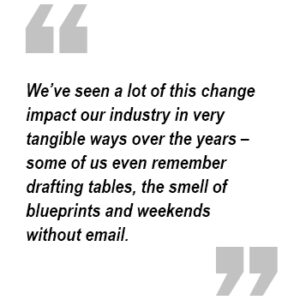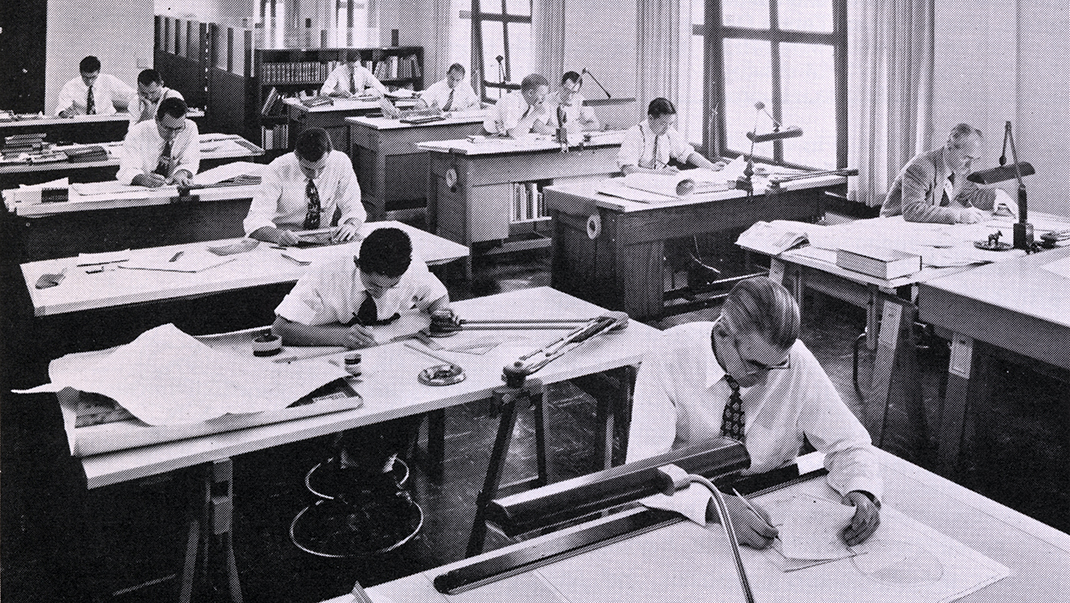If you’re using a computer to read this, you’ve probably heard of Moore’s Law. It’s the 1965 hypothesis by the co-founder of Intel, Gordon Moore, that computing power doubles every year or two. History has shown this projection to be largely accurate and the impact on our society has been profound.
What does Moore’s Law have to do with design-build, which is, after all, all about brick and mortar?
It turns out that the technology revolution is creating an underlying change to just about everything we do. We’ve seen a lot of this change impact our industry in very tangible ways over the years – some of us even remember drafting tables, the smell of blueprints, and weekends without email
 But technologies like BIM and CAD are only a small part of the story. The meaningful intersection of design-build and Moore’s Law is a fundamental shift in our collective expectations for results. The combination of the web, fast connections, smart phones, and something called “the cloud” have coalesced into an ecosystem of immediacy and real-time feedback. Think about the difference between a letter and an email – and now email is the new snail-mail compared to a text or a tweet or an Instagram – or whatever Moore’s Law predicts will be twice as fast next year. Another example: Remember filling out a paper order form from a catalog (Spiegel? Sears Roebuck?), an analog act that was mercifully replaced in a blink through the miracle of technology – the 800-number? Now, online sellers fear losing customers when a web page takes longer than a half-second to load.
But technologies like BIM and CAD are only a small part of the story. The meaningful intersection of design-build and Moore’s Law is a fundamental shift in our collective expectations for results. The combination of the web, fast connections, smart phones, and something called “the cloud” have coalesced into an ecosystem of immediacy and real-time feedback. Think about the difference between a letter and an email – and now email is the new snail-mail compared to a text or a tweet or an Instagram – or whatever Moore’s Law predicts will be twice as fast next year. Another example: Remember filling out a paper order form from a catalog (Spiegel? Sears Roebuck?), an analog act that was mercifully replaced in a blink through the miracle of technology – the 800-number? Now, online sellers fear losing customers when a web page takes longer than a half-second to load.
Technology pundits have a term for all of this: reducing friction. It’s a terrific analogy to visualize the removal of transactional barriers and superfluous resistance. Elimination of extra heat. Making things run smoothly.
Reducing friction also refers to eliminating intermediate brokers or middlemen. In addition to all the speed benefits brought about via Moore’s Law, the actual transaction is simplified. There’s no Fotomat standing between you and your pictures. You can buy your contact lenses straight from a warehouse or your next laptop from its factory while it’s still being assembled. You can get an Uber ride from here to there with barely a tap on your phone. If you’re lucky, you live in a state where you can renew your driver’s license without going to an obscure office, taking a paper number, and waiting to be called. It’s just a matter of time before the driving itself will be automated.
So, back to design-build: Given the removal of friction from virtually every aspect of our lives, why can’t a utility upgrade their water or wastewater plant in a way that makes the most sense? How can a special interest of one type or another dictate what form of project delivery is “wrong” (or right)? In whose interest is it that there are artificial, bureaucratic impediments to how things get designed, built, and operated?
On the Internet and in our daily lives, we have begun to be largely freed from artificial transaction friction. And now, we’re getting used to life with few, if any, barriers.
It’s only a matter of time before Moore’s Law overtakes brick-and-mortar law. It won’t be about doubling the speed of a concrete pour, but it will be about removing friction from the planning and implementation and doing what is best for the end result — without preconception for “how things have always been done before.”
Many of today’s younger generation of elected officials, utility directors, and project managers have now grown up in an environment unwilling to wait a half-second to order their groceries or their next TV (or a vacation rental, or a new car, or what’s next?). These same decision makers and influencers are simply not going to be willing to wait six months to select a consultant, another year to produce a design, another couple of months to put completed plans out to bid, sit on their hands during a bid period, and then basically have to start over explaining to the winning low bidder what was really intended in the design and then eventually, maybe, start to build the project.
And then, part way through construction, the arguments about change orders start. And finally, who is responsible for the completed project actually functioning as promised? Metaphorically, the browser window will have been closed long before traditional design-bid-build can load.
Let’s be specific. With design-build’s collaborative approach Moore’s Law will remove friction from infrastructure delivery by applying:
- Transparency. Details, no matter how complex or numerous, can (and should) be made available to all — and all detail can be made transparent and auditable. There’s no practical reason to obscure pricing and productivity information to the finest level. Black-box, hard-bid pricing will mean the same as “paying retail” in the Amazon age.
- Collaboration. We can (and do) communicate seamlessly, whenever needed, in any imaginable format. There are few practical or physical barriers to interacting and solving problems efficiently and at their origin. Formal dispute-resolution matrices can hardly stand up to Skype and FaceTime.
- Visualization. Projects can be “visualized” optically, financially, and operationally concurrently with planning, design, and construction. Virtual and augmented reality are staged for huge advances – this is the next big thing. However, fundamental to any visualization is assembling all of the data at the outset to create a full picture. Visualization and the insight gained from it requires all contributors to be present at the outset. Linear project development will be as outmoded as setting type in lead.
- Pace of Play. Technology certainly allows faster conceptualization and design and even speeds up physical construction. But, the lasting impact of Moore’s Law isn’t about simply going faster. We now work effectively in parallel tracks and we expect immediate results. When there are challenges, we expect instant communication and resolution. Waiting is friction. When the chat room is live, there’s no time to send a letter or wait on hold. (All lines are busy, we’ll be with you in the order your call was received … Uggghh!).
- Change. Constant, relentless, and ubiquitous change is fundamental to Moore’s Law. When computing power doubles, it makes no sense to rely on last year’s solution. Where our water and wastewater practice has relied on precedent and proven approaches, our real world now relies on there always being new methods to tackle problems … there’s an app for that! Relying on last year’s delivery model, procurement documents, and contract might be reliable, but so were dial-up modems – and we don’t use them anymore.
Moore’s Law will drive the friction out of brick-and-mortar infrastructure delivery, just as it has altered our society in every other way. The evolution to “anything goes that works” in our industry has certainly been slowed by institutional resistance, but impediments are bound to fall.
It’s no longer responsible or realistic to say, “We can’t do it that way.” We must all ask, “Why not?” If you don’t, somebody else will.
This article was originally published on the Water Design-Build Council blog. You can view more posts from WDBC here.
